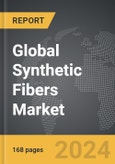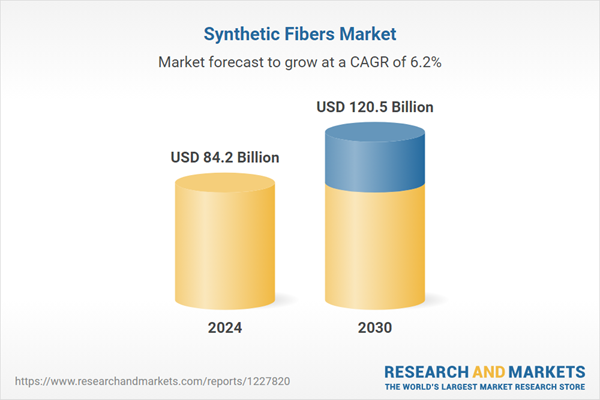The global market for Synthetic Fibers was valued at US$84.2 Billion in 2024 and is projected to reach US$120.5 Billion by 2030, growing at a CAGR of 6.2% from 2024 to 2030. This comprehensive report provides an in-depth analysis of market trends, drivers, and forecasts, helping you make informed business decisions. The report includes the most recent global tariff developments and how they impact the Synthetic Fibers market.
Technological advancements have significantly enhanced the production and application of synthetic fibers. Innovations in fiber technology have led to the creation of microfibers, which are finer than silk and offer superior softness and comfort, making them popular in high-end fashion and luxury bedding. The introduction of bi-component fibers, which combine two different polymers, has expanded the functionality of synthetic fabrics, offering benefits like improved thermal properties and better dye absorption. Additionally, advancements in recycling technologies are allowing for the production of eco-friendly synthetic fibers from post-consumer plastic waste, addressing environmental concerns associated with traditional synthetic fiber production. These sustainable initiatives are gaining traction, driven by increasing consumer demand for environmentally responsible products and stricter regulations on plastic waste management.
The growth in the synthetic fibers market is driven by several factors. Firstly, the rising demand for durable and easy-care textiles in the fashion and home furnishing industries is propelling market expansion. Consumers are increasingly opting for synthetic fabrics due to their affordability, versatility, and low maintenance compared to natural fibers. Secondly, the booming automotive and construction industries are driving the demand for high-strength and lightweight synthetic fibers used in composites and insulation materials. Thirdly, the advancements in textile technology and the continuous innovation in fiber properties are enhancing the performance and appeal of synthetic fibers, leading to their increased adoption in specialized applications such as medical textiles, filtration, and geotextiles. Moreover, the growing awareness and preference for sustainable products are fostering the development and consumption of recycled and bio-based synthetic fibers. Lastly, the robust growth of the global apparel industry, particularly in emerging markets, is significantly contributing to the demand for synthetic fibers, as manufacturers seek cost-effective and high-performance materials to meet the needs of a diverse consumer base. These factors collectively are expected to drive the synthetic fibers market's robust growth in the coming years.
Segments: Product (Polyester, Nylon, Acrylics, Polyolefins, Other Products); Application (Clothing, Home Furnishing, Automotive, Filtration, Other Applications).
Geographic Regions/Countries: World; United States; Canada; Japan; China; Europe (France; Germany; Italy; United Kingdom; Spain; Russia; and Rest of Europe); Asia-Pacific (Australia; India; South Korea; and Rest of Asia-Pacific); Latin America (Argentina; Brazil; Mexico; and Rest of Latin America); Middle East (Iran; Israel; Saudi Arabia; United Arab Emirates; and Rest of Middle East); and Africa.
The analysts continuously track trade developments worldwide, drawing insights from leading global economists and over 200 industry and policy institutions, including think tanks, trade organizations, and national economic advisory bodies. This intelligence is integrated into forecasting models to provide timely, data-driven analysis of emerging risks and opportunities.
Synthetic Fibers - Key Trends and Drivers
Synthetic fibers have revolutionized the textile industry since their inception in the early 20th century, providing an alternative to natural fibers like cotton, wool, and silk. These man-made fibers, including polyester, nylon, acrylic, and spandex, are derived from petrochemicals through polymerization processes. The unique properties of synthetic fibers, such as high tensile strength, durability, elasticity, and resistance to moisture, mildew, and shrinkage, have made them highly desirable across various applications. They are extensively used in apparel, home furnishings, industrial applications, and technical textiles. The ability to engineer these fibers to meet specific functional requirements has also spurred innovation, leading to the development of high-performance fabrics used in sportswear, outdoor gear, and protective clothing.Technological advancements have significantly enhanced the production and application of synthetic fibers. Innovations in fiber technology have led to the creation of microfibers, which are finer than silk and offer superior softness and comfort, making them popular in high-end fashion and luxury bedding. The introduction of bi-component fibers, which combine two different polymers, has expanded the functionality of synthetic fabrics, offering benefits like improved thermal properties and better dye absorption. Additionally, advancements in recycling technologies are allowing for the production of eco-friendly synthetic fibers from post-consumer plastic waste, addressing environmental concerns associated with traditional synthetic fiber production. These sustainable initiatives are gaining traction, driven by increasing consumer demand for environmentally responsible products and stricter regulations on plastic waste management.
The growth in the synthetic fibers market is driven by several factors. Firstly, the rising demand for durable and easy-care textiles in the fashion and home furnishing industries is propelling market expansion. Consumers are increasingly opting for synthetic fabrics due to their affordability, versatility, and low maintenance compared to natural fibers. Secondly, the booming automotive and construction industries are driving the demand for high-strength and lightweight synthetic fibers used in composites and insulation materials. Thirdly, the advancements in textile technology and the continuous innovation in fiber properties are enhancing the performance and appeal of synthetic fibers, leading to their increased adoption in specialized applications such as medical textiles, filtration, and geotextiles. Moreover, the growing awareness and preference for sustainable products are fostering the development and consumption of recycled and bio-based synthetic fibers. Lastly, the robust growth of the global apparel industry, particularly in emerging markets, is significantly contributing to the demand for synthetic fibers, as manufacturers seek cost-effective and high-performance materials to meet the needs of a diverse consumer base. These factors collectively are expected to drive the synthetic fibers market's robust growth in the coming years.
Report Scope
The report analyzes the Synthetic Fibers market, presented in terms of units. The analysis covers the key segments and geographic regions outlined below.Segments: Product (Polyester, Nylon, Acrylics, Polyolefins, Other Products); Application (Clothing, Home Furnishing, Automotive, Filtration, Other Applications).
Geographic Regions/Countries: World; United States; Canada; Japan; China; Europe (France; Germany; Italy; United Kingdom; Spain; Russia; and Rest of Europe); Asia-Pacific (Australia; India; South Korea; and Rest of Asia-Pacific); Latin America (Argentina; Brazil; Mexico; and Rest of Latin America); Middle East (Iran; Israel; Saudi Arabia; United Arab Emirates; and Rest of Middle East); and Africa.
Key Insights:
- Market Growth: Understand the significant growth trajectory of the Polyester segment, which is expected to reach US$60.8 Billion by 2030 with a CAGR of a 6.4%. The Nylon segment is also set to grow at 6.7% CAGR over the analysis period.
- Regional Analysis: Gain insights into the U.S. market, valued at $22.0 Billion in 2024, and China, forecasted to grow at an impressive 9.2% CAGR to reach $27.6 Billion by 2030. Discover growth trends in other key regions, including Japan, Canada, Germany, and the Asia-Pacific.
Why You Should Buy This Report:
- Detailed Market Analysis: Access a thorough analysis of the Global Synthetic Fibers Market, covering all major geographic regions and market segments.
- Competitive Insights: Get an overview of the competitive landscape, including the market presence of major players across different geographies.
- Future Trends and Drivers: Understand the key trends and drivers shaping the future of the Global Synthetic Fibers Market.
- Actionable Insights: Benefit from actionable insights that can help you identify new revenue opportunities and make strategic business decisions.
Key Questions Answered:
- How is the Global Synthetic Fibers Market expected to evolve by 2030?
- What are the main drivers and restraints affecting the market?
- Which market segments will grow the most over the forecast period?
- How will market shares for different regions and segments change by 2030?
- Who are the leading players in the market, and what are their prospects?
Report Features:
- Comprehensive Market Data: Independent analysis of annual sales and market forecasts in US$ Million from 2024 to 2030.
- In-Depth Regional Analysis: Detailed insights into key markets, including the U.S., China, Japan, Canada, Europe, Asia-Pacific, Latin America, Middle East, and Africa.
- Company Profiles: Coverage of players such as Bombay Dyeing & Manufacturing Co., Ltd., China National Petroleum Corporation (CNPC), E. I. du Pont De Nemours and Company, Indorama Corporation, Lenzing Group and more.
- Complimentary Updates: Receive free report updates for one year to keep you informed of the latest market developments.
Some of the 42 companies featured in this Synthetic Fibers market report include:
- Bombay Dyeing & Manufacturing Co., Ltd.
- China National Petroleum Corporation (CNPC)
- E. I. du Pont De Nemours and Company
- Indorama Corporation
- Lenzing Group
- Mitsubishi Chemical Holdings Corporation
- Reliance Industries Ltd.
- Teijin Ltd.
- Teijin Ltd.
- Toray Industries, Inc.
- Toyobo Co., Ltd.
Tariff Impact Analysis: Key Insights for 2025
Global tariff negotiations across 180+ countries are reshaping supply chains, costs, and competitiveness. This report reflects the latest developments as of April 2025 and incorporates forward-looking insights into the market outlook.The analysts continuously track trade developments worldwide, drawing insights from leading global economists and over 200 industry and policy institutions, including think tanks, trade organizations, and national economic advisory bodies. This intelligence is integrated into forecasting models to provide timely, data-driven analysis of emerging risks and opportunities.
What’s Included in This Edition:
- Tariff-adjusted market forecasts by region and segment
- Analysis of cost and supply chain implications by sourcing and trade exposure
- Strategic insights into geographic shifts
Buyers receive a free July 2025 update with:
- Finalized tariff impacts and new trade agreement effects
- Updated projections reflecting global sourcing and cost shifts
- Expanded country-specific coverage across the industry
Table of Contents
I. METHODOLOGYII. EXECUTIVE SUMMARY2. FOCUS ON SELECT PLAYERSIII. MARKET ANALYSISCANADAITALYSPAINRUSSIAREST OF EUROPESOUTH KOREAREST OF ASIA-PACIFICARGENTINABRAZILMEXICOREST OF LATIN AMERICAIRANISRAELSAUDI ARABIAUNITED ARAB EMIRATESREST OF MIDDLE EASTIV. COMPETITION
1. MARKET OVERVIEW
3. MARKET TRENDS & DRIVERS
4. GLOBAL MARKET PERSPECTIVE
UNITED STATES
JAPAN
CHINA
EUROPE
FRANCE
GERMANY
UNITED KINGDOM
ASIA-PACIFIC
AUSTRALIA
INDIA
LATIN AMERICA
MIDDLE EAST
AFRICA
Companies Mentioned (Partial List)
A selection of companies mentioned in this report includes, but is not limited to:
- Bombay Dyeing & Manufacturing Co., Ltd.
- China National Petroleum Corporation (CNPC)
- E. I. du Pont De Nemours and Company
- Indorama Corporation
- Lenzing Group
- Mitsubishi Chemical Holdings Corporation
- Reliance Industries Ltd.
- Teijin Ltd.
- Teijin Ltd.
- Toray Industries, Inc.
- Toyobo Co., Ltd.
Table Information
| Report Attribute | Details |
|---|---|
| No. of Pages | 168 |
| Published | April 2025 |
| Forecast Period | 2024 - 2030 |
| Estimated Market Value ( USD | $ 84.2 Billion |
| Forecasted Market Value ( USD | $ 120.5 Billion |
| Compound Annual Growth Rate | 6.2% |
| Regions Covered | Global |









